|
Monday, April 6, 2009
Progress Notes
One of the features of Miller County which has always made it unique has been the Osage River (photo 01).
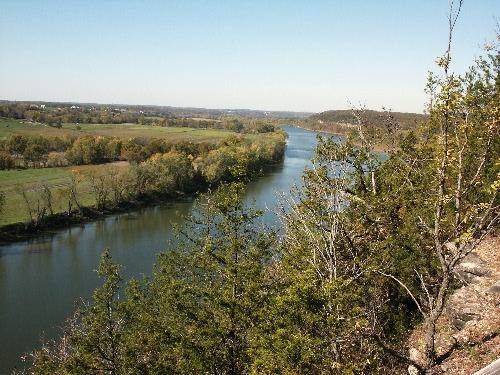
01 Osage River
Without the river, we still would have been one of many southern Missouri counties graced by beautiful wooded hills and spring fed creeks. But the river gave early settlers a way to get to the interior of the state more easily than travel over forest covered land which had few trails. Later, the river served as a means of facilitating commerce providing a water passage into the interior big enough that rafts, barges and later steamboats could bring goods from St. Louis to the river communities and on return carry livestock, various types of farm produce, and later even railroad ties when the railroads began to be built. Of course, it was the railroad which eventually replaced the steamboat for commerce, but that was many years later, not until the 1890’s. Many interior Missouri towns which were located on the banks of the Osage River prospered due to the river traffic. And, of course, it was the river which recently brought our area into the world news spotlight for a day or two regarding the construction of the new bridge at Tuscumbia.
The last steamboat to be used commercially on the Osage River was the Homer C Wright (photo 02), named after the son of C.B. Wright (photos 03 and 04), one of the owners of the Anchor Mill Company at Tuscumbia, which at one time was one of the county’s most successful businesses.
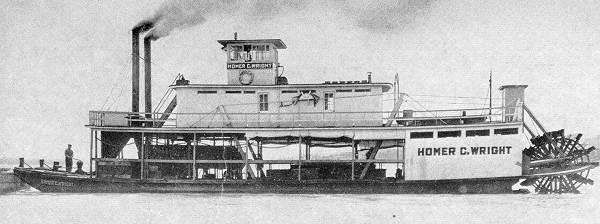
02 Homer C Wright Steamboat
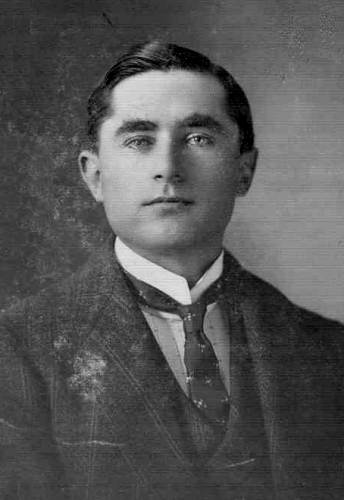
03 Clarence Boyce Wright
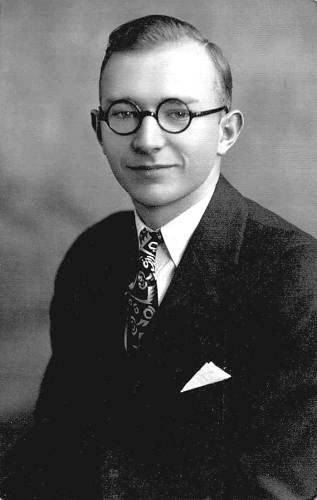
04 Homer Clay Wright
After the Homer C Wright was sold, the river wasn’t used much commercially for many years. However, for a period of time in the 1980’s, a couple of companies used barges on the Osage River to carry gravel to a shipping point to be used for commercial use. The story of this more recent enterprise on the river was told in an article by James Sparks published in the Eldon Advertiser August 13, 1987. Presently, the gravel barges no longer operate on the Osage River, but since this enterprise was the last I know of to utilize the river for commerce, I thought it would be interesting to copy it here. The photos are copied from the newspaper article so are not of optimum clarity:
Barges Still Toiling In The Osage River
By James Sparks
Eldon Advertiser, August 13, 1987
From the late 1830’s until the 1920’s, the riverboats and their barges had the claim to the waterway that once ran from as far away as For Scott, Kansas to where Osage City sits near the Missouri River.
But with the coming of better roads, better trucks and more avenues for the railroad, the barges became economically unfeasible, and slowly, the once proud family owned business faded from the scene. The once booming river towns either became ghost towns or found other ways to survive.
The creation of Bagnell Dam in 1931 all but sealed the fate of riverboat traffic on the Osage River, sealing off the north and west accesses. But today, two businesses still use tugs and barges to carry their merchandise, and one of those is located just downriver from Bagnell Dam.
Dam Red-E-Mix of Osage Beach has a river and sand plant just off the Highway 54 bridge over the Osage River. According to Mike Keeth of the plant, the tugboat called the Charger and two large river barges from the Mississippi River are the primary means the company has of getting sand and gravel from the island below the dam to the plant (photos 05 and 06).
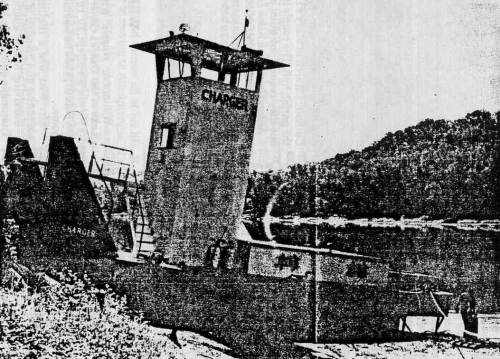
05 The Charger
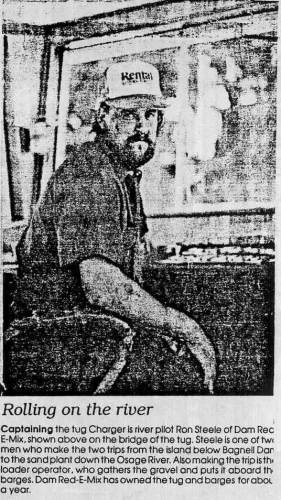
06 Ron Steele on The Charger
Click image for larger viewThe other business using the tugs and barges is the Skip McGloughlin owned company called Calloway Sand on Highway 50 near Osage City, where the Osage River empties into the Missouri River.
The Charger formerly belonged to the Coast Guard, and has kept its name through the change of ownership. Last week, Keeth and the tug’s pilot, Ron Steele, had to dry-dock the tug to replace a propeller and remove a twisted piece of metal from the propeller shaft (photo 07).
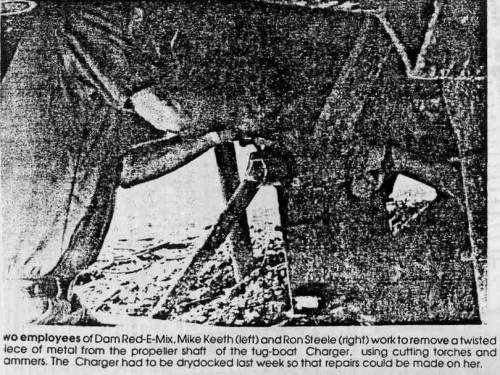
07 Repairing Propeller
Click image for larger view
Keeth said the tug and barges can only operate when the water is being generated from the dam, and that in the times when it isn’t the Company relies on a dredge further downstream to bring up the gravel and sands from the bottom.
“We occasionally run to Tuscumbia,” Keeth said. “But we can’t get through that part of the river right now. They’ve got to be generating at the dam before we can move.”
“We pick up the gravel at the island using loaders, put them on the barges and carry them the half mile downstream to the company,” he said. “There it goes through the plant, where it is washed and separated.”
Keeth said the company sells its sand to businesses as far away as in Lincoln, Nebraska. The Lincoln Company sends its own trucks down to haul the product back home.
“The tug and barges are the only means we have of getting the sand,” he said. “We usually make two trips a day, depending how the generation goes. The barges have hauled 400 tons of sand and gravel to the plant per day. The barges have been owned by the plant about a year (photo 08),” Keeth said.
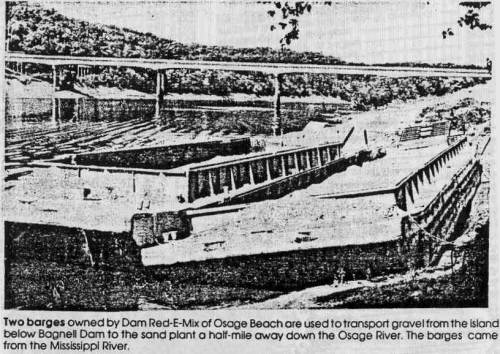
08 Barges
Click image for larger view
It only takes the boat operator and the loader operator to make the runs to the island and back. The loader operator uses a wheel loader to bring the sand onto the barge and to remove it back at the plant.
Sand and gravel are all the barges carry nowadays. But in the early part of this and the last centuries, barges once carried bacon, wheat, corn, whiskey, deerskins, furs and beeswax both to and from towns on the river.
Farmers used to bring their goods to various points on the river, where the steamboats and barges would pick them up and carry them on to St. Louis for nationwide distribution.
Zebulon M. Pike (photo 09) was one of the first explorers of the Osage River, following it as far as the Kansas prairies, according to Judge Clyde Lee Jenkins’ book, “The History of Miller County.”

09 Zebulon Pike
At that time, the river was little more than a stream with “shallows, hairpin turns, sandbars and tricky currents,” according to Jenkins’ book. Only flat and keelboats could get in and out of the various obstacles and obstructions.
But the only other way of travelling was the overland route, by foot, oxen and horseback, and the travel was much too rough. By the late 1830’s, the first steamboats were on the Osage River.
The development of the river’s transportation potential began in earnest in 1838, when the steamboat Adventure navigated the Osage River a distance of almost 200 miles. In 1840, the Choteau Belle hauled freight up to a rapidly growing Tuscumbia, and in 1841 the Leander carried approximately 200 tons of freight from Warsaw to Osceola, proving the Osage River was navigable and could be made more so.
During flooding on the river, a boat called the Maid of Osage managed to make a trip to Papinsville in Bates County, then went on to Harmony Mission and Sun’s Point. Citizens began petitioning for the development of the river into a navigable waterway. Work began to create a route from Osceola to the Missouri. Along this route, steamships carried their goods to main ports of Lisletown at the mouth of the Maries and Osage rivers, Tuscumbia, Linn Creek, Warsaw, Osceola, Taborville and Papinsville. Of these, Tuscumbia perhaps became the most important river port for southwest Missouri and northern Arkansas.
In 1852, Joseph Washington McClurg (photo 10) established his business at Linn Creek, becoming one of the most successful entrepreneurs of riverboat traffic.
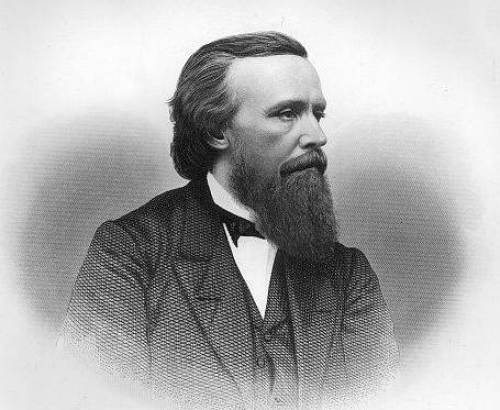
10 Joseph Washington McClurg
His four steamships: the Emma, the Alliance, the Mary C. and the Linn Creek helped develop his fortunes, which would later aid him in landing the office of Missouri governor after the Civil War.
At one time, McClurg chartered 13 steamboats to move down the Ohio River to his wholesale business at Linn Creek, carrying goods worth over $8,000, a tidy sum back in those days.
McClurg, at first with his partners but later alone, distributed tons of processed beef and pork annually to St. Louis by way of the river, while importing manufactured goods from as far away as Liverpool, England. Linn Creek grew more important as McClurg’s business flourished.
Following his stint as Missouri governor after the Civil War, McClurg resumed his investments on the river, and maintained his steamboat business. Iron and lead production in the area consumed much of his attention at this time, and soon that became an export. One such iron production plant was located in Irontown, a small boomtown on Bolinger Creek, 12 miles northwest of Linn Creek.
McClurg continued to profit up until 1885, exporting pig iron on flatboats and small steamers. The surprising part was, he profited using a business that was only good four to six months per year, when the shallow Osage was navigable.
He continued to work hard at the river’s development, realizing the longer it could be navigated, the more dollars flowed into his own pockets.
But in the 1880’s, he and the other riverboat companies fell on hard times. The roads were improved. Steamboat stock fell off, and most people used the railroad to ship goods to and fro. The boats were no longer feasible time wise and economically. McClurg soon got out of the business that had built his empire.
But some still used the river for their business. Anchor Mill of Tuscumbia is one example. The steamer J.R. Wells (photo 11) was one such boat, built in 1897 and under the supervision of Captain Phil F. Hauenstein (photo 12) and master mechanic Joseph Shepherd.
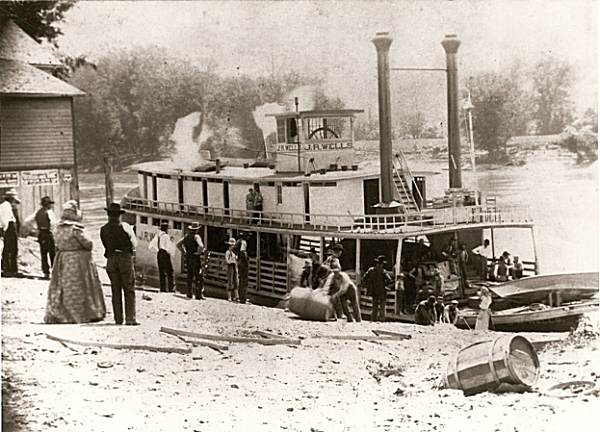
11 J.R. Wells unloading at Tuscumbia
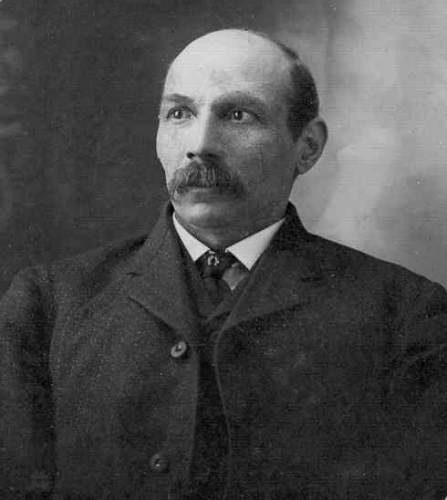
12 Phil Hauenstein
Commissioned in April, 1898, the Wells carried wheat primarily, along with hard and soft lumber.
In 1907, the J.R. Wells ran on a regular schedule between St. Louis and Linn Creek, taking about two weeks for a round trip. Hogs were another important, but smelly proposition, and the boats carried those, too.
The Homer C. Wright was the last of the steamboats to make runs along the river. It was operated regularly from 1920 to 1923. But the better trucks had come, with better roads to use. And the Homer C. Wright was put up for sale. After that, boating on the river as a business was pretty much over. With the construction of the dam in 1931, an era was at an end.
Some of the barges used by the steamboats in those days were nearly 100 feet long. One boat could haul what two or three railroad cars could. But in the end, it was the time saved each haul that killed the steamboat/barge businesses.
In addition to Tuscumbia, other towns which boomed on the river included St. Thomas and St. Elizabeth. They still survive today. Other towns weren’t so fortunate. Towns such as Hoecker and Erie, Old Linn Creek and Zebra faded from the scene with the end of the dreams of those who thought the era of riverboats and barges would never end. They were wrong, of course.
But as long as The Charger and her barges continue to move through the channels of the Osage River, the memory of the greatness of the river’s past, the fortunes it created, and the aid it gave in the development of this area will remain.
Last Saturday our museum quilt maker, Elva Boyd Steen (photo 013 - Elva at the Museum), celebrated her 85th birthday at the Ninth Street Christian Church in Eldon at a gathering planned and produced by her children.
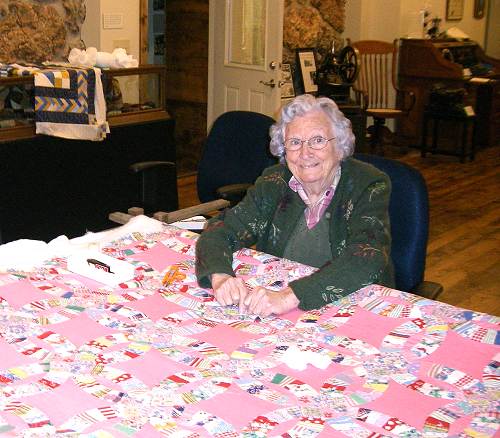
13 Elva Boyd Steen
The most interesting feature of the event was the display of many of the quilts Elva has made through the years. Although by no means even close to the total number she has quilted, the entire gymnasium of the church was literally inundated by Elva quilts (photos 14, 15 and 16).
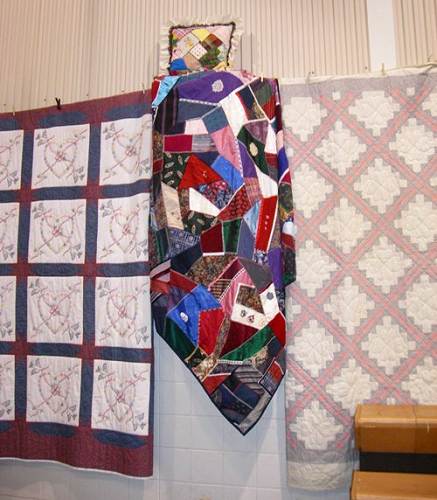
14 Multi Colors and Shapes

15 Quilts on Wall and Bannister

16 Standing Quilts
Every wall had quilts hanging next to each other from corner to corner. A couple of displays featured dresses and memorabilia (photos 17 and 18).

17 Quilts and Dresses

18 Memorabilia
Quilts were displayed on the floor and in the hall ways, all made by Elva. It took an entire day to get them all placed or hung. Elva has always been generous with her quilts giving them away as gifts over the years. Amazingly, Elva didn’t start quilting until later in life since she had too much to do raising a family and helping Holmes, her husband, take care of the farm. We are grateful now that Elva is so generously donating her time to quilt at the museum every Monday.
The event was attended by many friends and relatives from all parts of the county, Iberia to Eldon and in between. Some came from as far away as Washington State on the west, Texas to the south, Chicago and Michigan to the North and Tennessee to the East. Elva came early to greet everyone (photo 19).
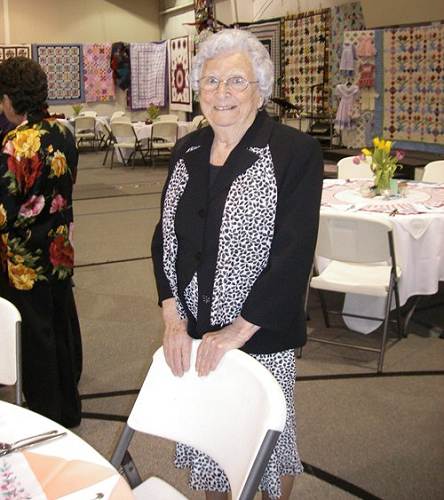
19 Elva Boyd Steen
One Steen related family from Jefferson City, the Drivers’, were especially interesting because of their long time association with Miller County through their ancestor, William Driver, one of our area’s most famous fiddle players. I have written several times about the Driver family. Listed below are three of the websites where I have featured articles about them:
Driver family history:
http://www.millercountymuseum.org/080811.html
Juny’s visit to the Museum:
http://www.millercountymuseum.org/080818.html
Bill Driver, the fiddler:
http://www.millercountymuseum.org/081208.html
This is the site which has two downloads of Bill playing the fiddle.
Other places on our website which feature the Driver family are:
http://www.millercountymuseum.org/people/bio_d.html
http://www.millercountymuseum.org/bios/bio_black.html
Those of the Driver family who came Saturday were Annette Driver (photo 20), her brother Darryl Clarence Jr. (Juny) Driver (photo 21), and Juny’s three delightful children, Derek, Danielle, and Daren.
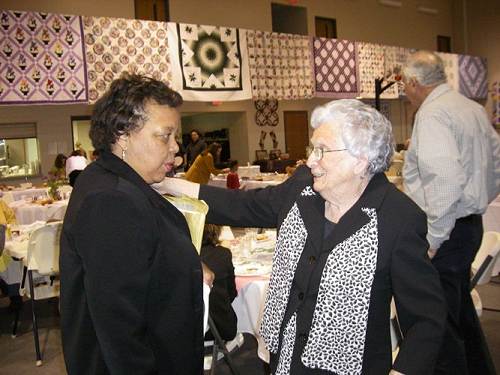
20 Annette Driver talking to Elva
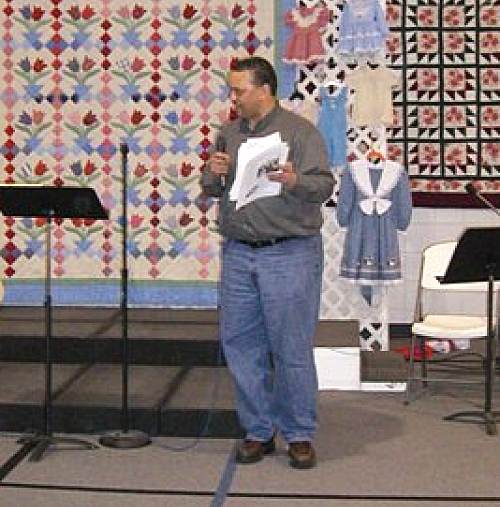
21 Clarence Juny Driver
Here is a photo of my granddaughter, Liza McHugh and Danielle having a wonderful time (photo 22).

22 Liza and Danielle
They share a common ancestry to the early Miller County settler, John Williams. John was the fourth great grandfather of Liza and fifth great grandfather of Danielle.
Annette Driver was the owner and operator of Driver’s barbeque of Jefferson City. The Steen family often dined at the barbecue through the years and in addition has used the Driver catering services as well. Presently, Annette is Activity Coordinator of Agriculture and Environmental Sciences at Lincoln University. Additionally, she is working on an MBA (Masters of Business Administration) with a special interest in Brand marketing. She plans to expand the scope and direction of the Drivers’ Brand and its business enterprise. Presently, she is the owner of the Driver's Food Brand which consisted of restaurants but in the future wants to lean more toward selling the Driver food products in grocery stores, supermarkets, government entities etc.
Clarence (Juny) is an attorney with Hanrahan Trapp PC of Jefferson City, and has occasion to come to the courthouse in Tuscumbia for legal work every once in a while.
Another special guest at Elva’s birthday celebration was Elva’s cousin, Stanley McDaniel of Johnson City, Tennessee (photo 23), who gave a very heart warming testimony as to how Elva was of great inspiration to him years ago when he was pursuing his education.

23 Stanley McDaniel
Presently, Stanley is a professor at the University of Tennessee. Stanley’s grandfather was George McDaniel, about whose farm and cave I discussed in last week’s Progress Notes.
One of the projects we are working to finish soon is the placement of the old Tuscumbia Presbyterian Church Bell on a concrete base partially enclosed in a vestibule with a roof to protect it from the environment. Here is a photo taken last week of Jim Clark (on the right) and Jack Wiggins (on the left) pouring and smoothing out the concrete for the base (photo 24).
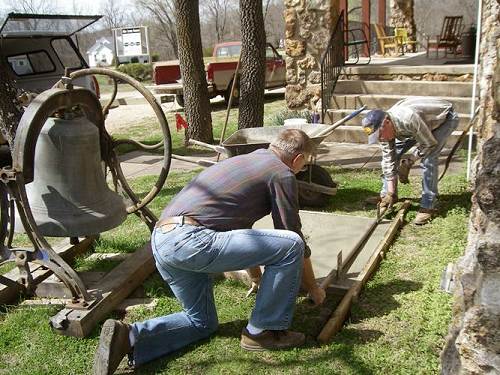
24 Jack Wiggins and Jim Clark
Jim is an experienced concrete layer and we are quite fortunate to have him to help us with this project. Jack is an experienced painter and has been very busy this winter with several painting projects inside the museum. The bell will be rung for the first time ceremoniously at our “Grand Reopening” ceremony Saturday, May 16 at which time will be featured speakers State Senator Carl Vogel, State Representative Rodney Schad, and Miller County Presiding Commissioner, Tom Wright. Many activities are planned for the day including a taffy pull, rope making, tie whacking, old time country music by the Joe Jeffries group, weaving demonstrations, and tours of the museum where over the winter we have put in place many new exhibits.
That's all for this week.
 Joe Pryor
|



